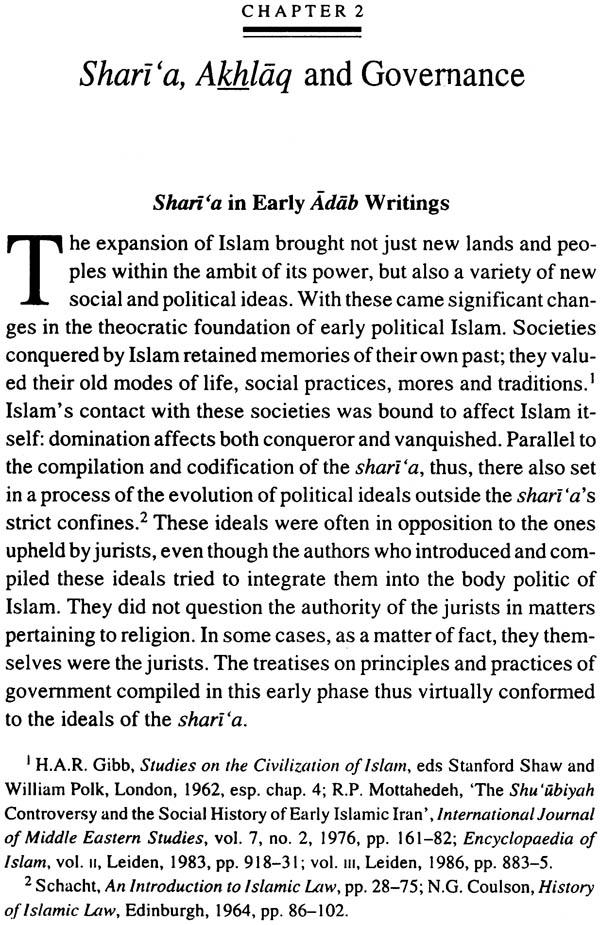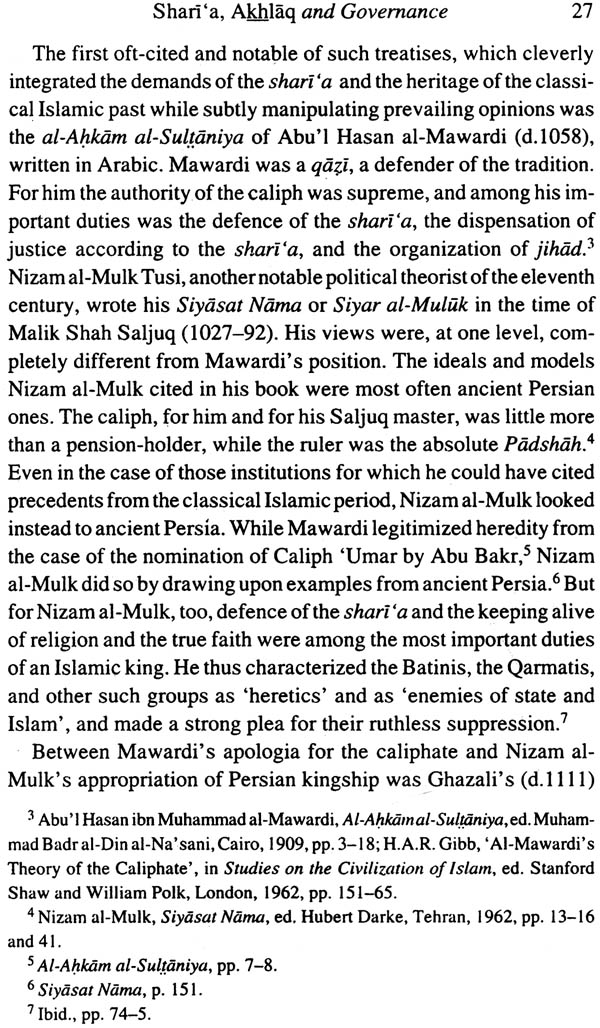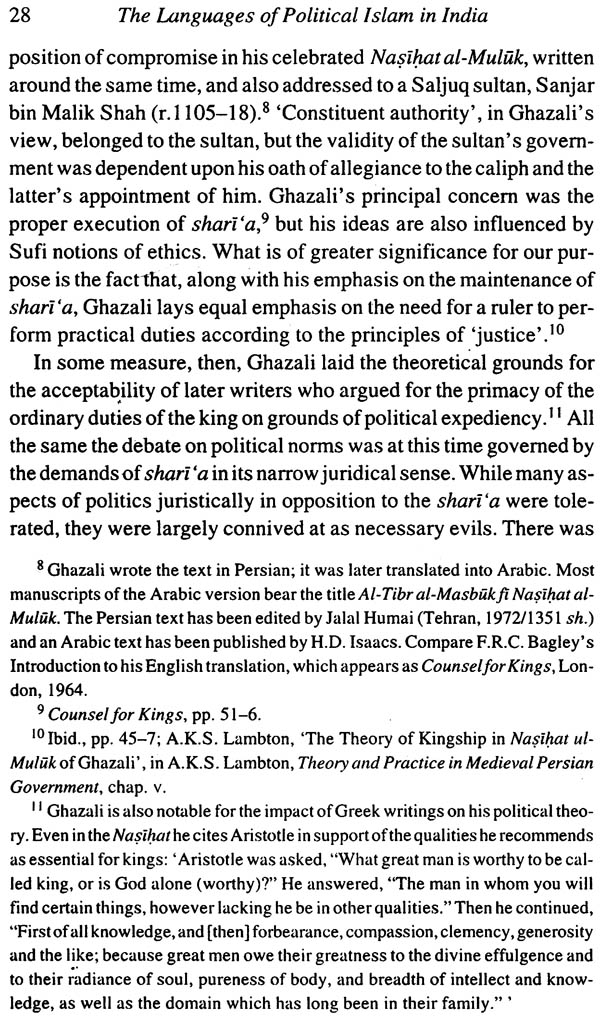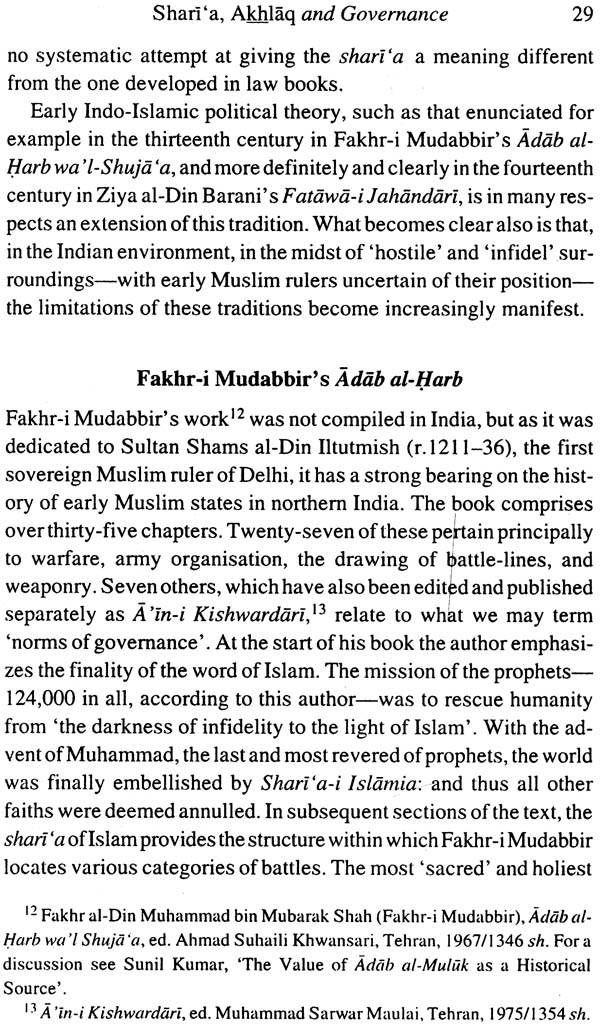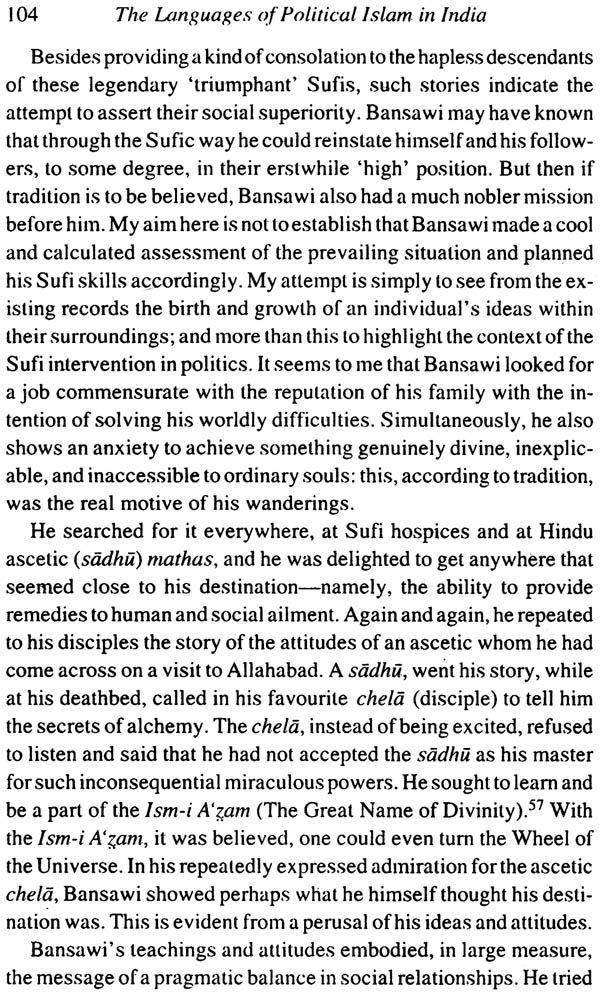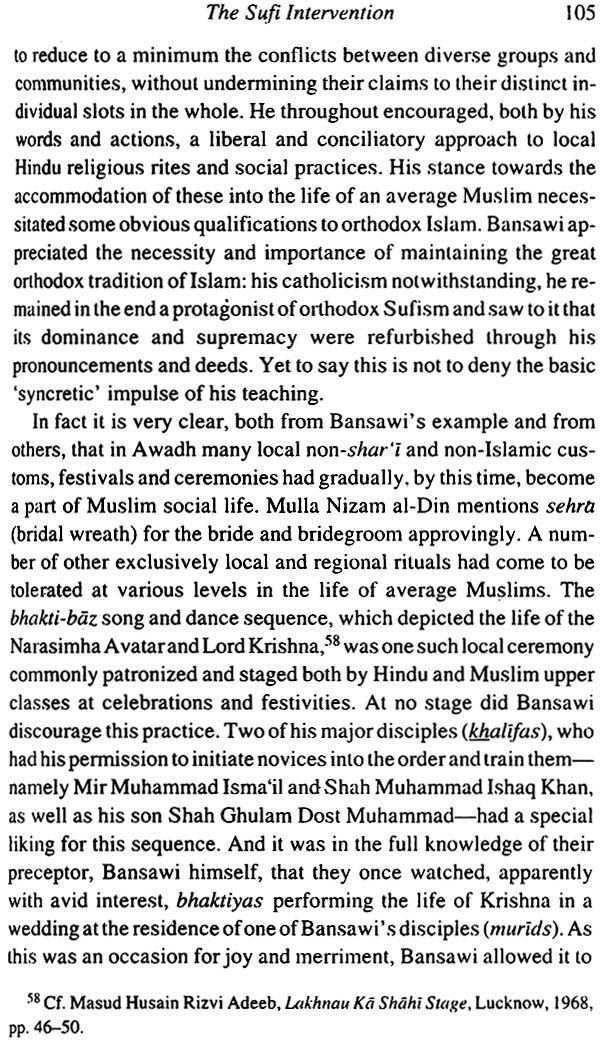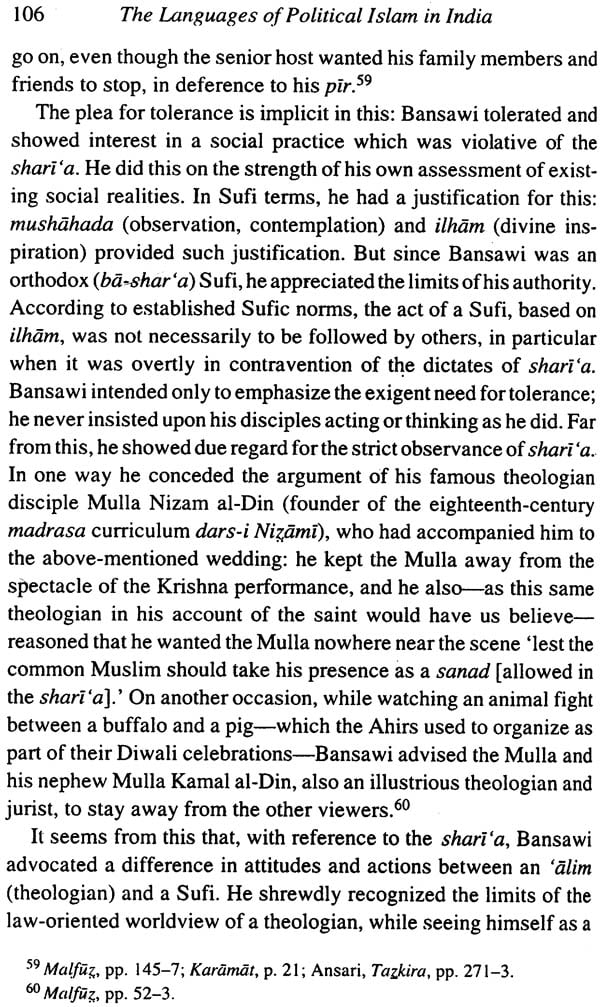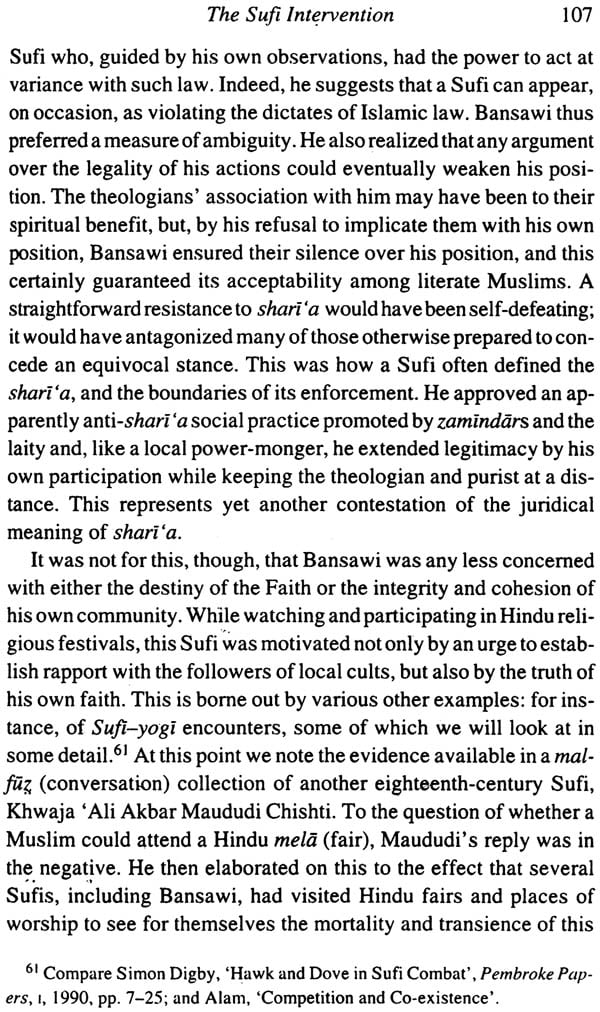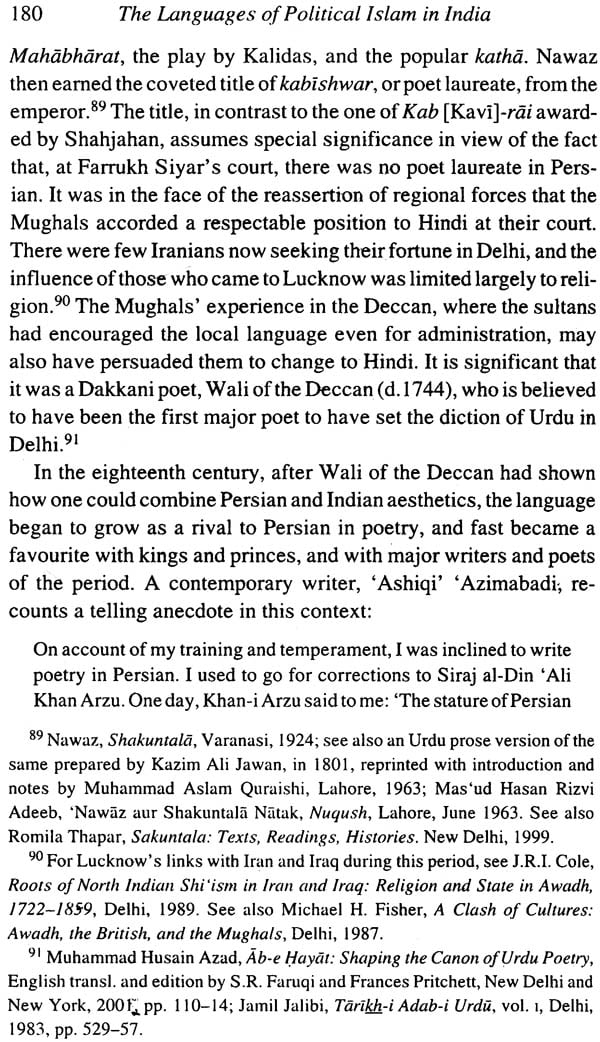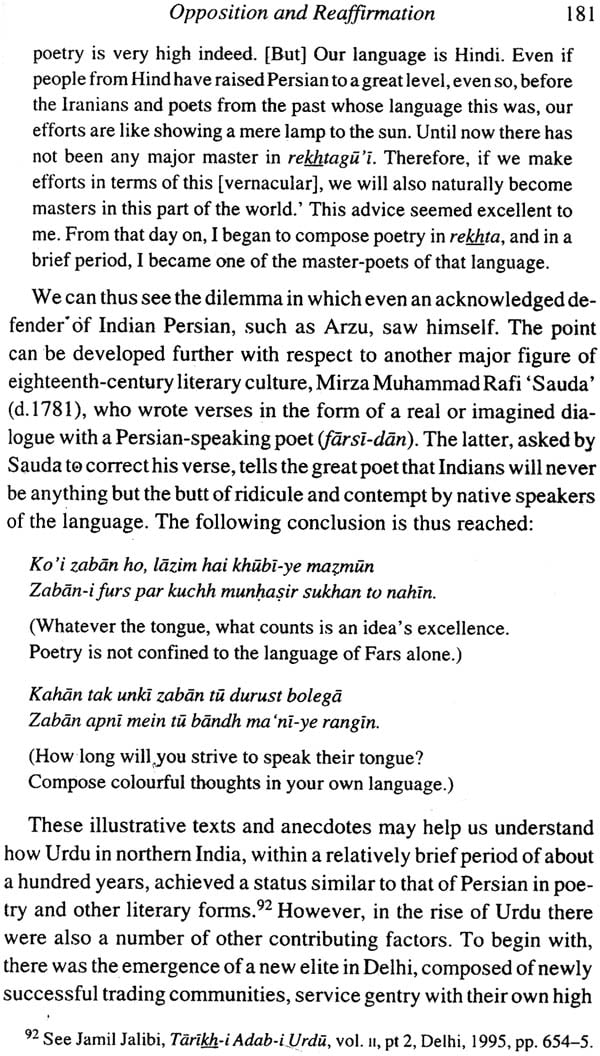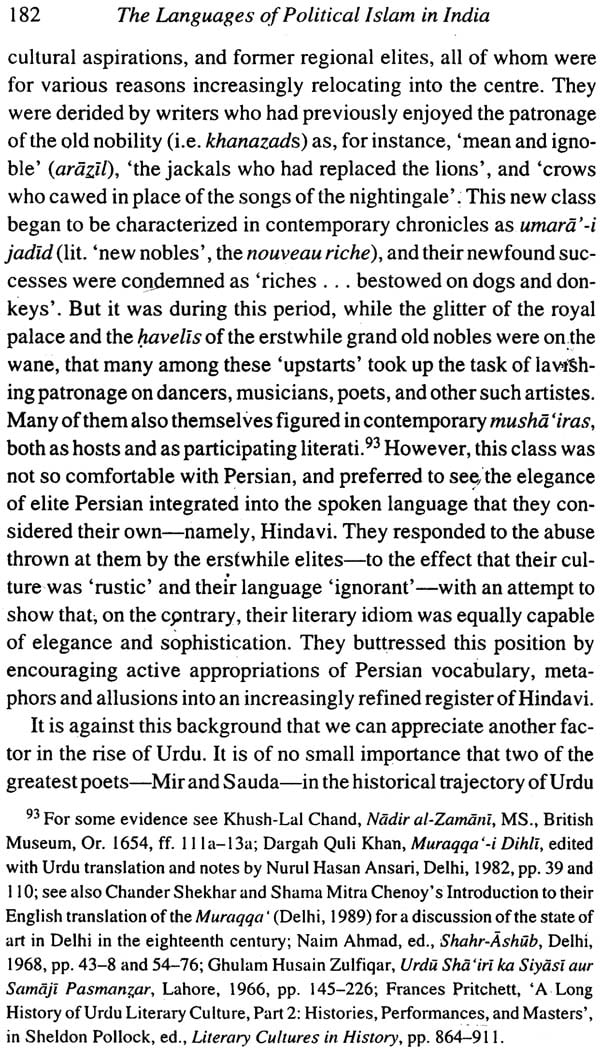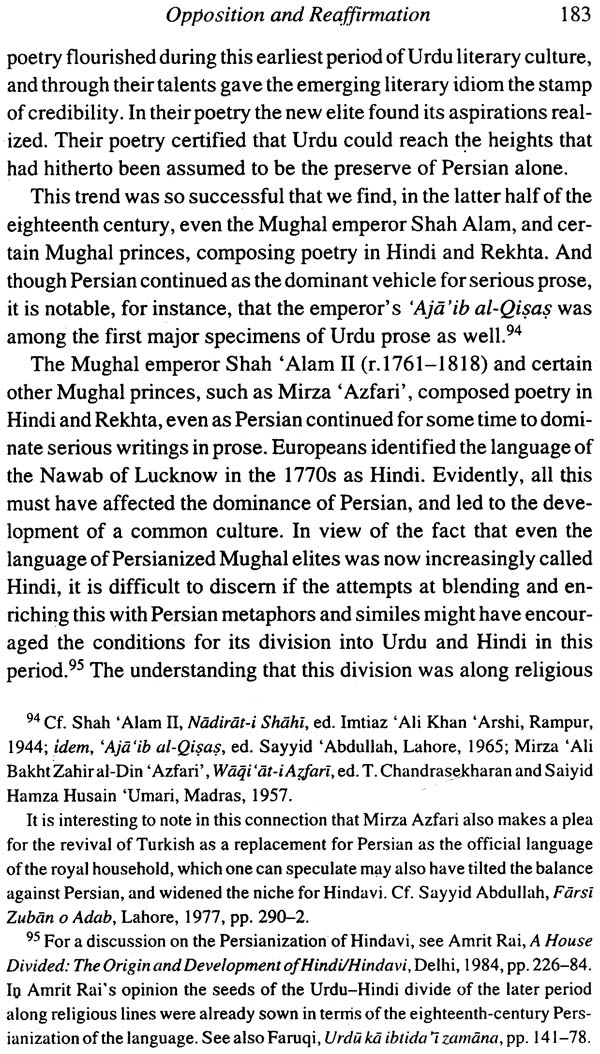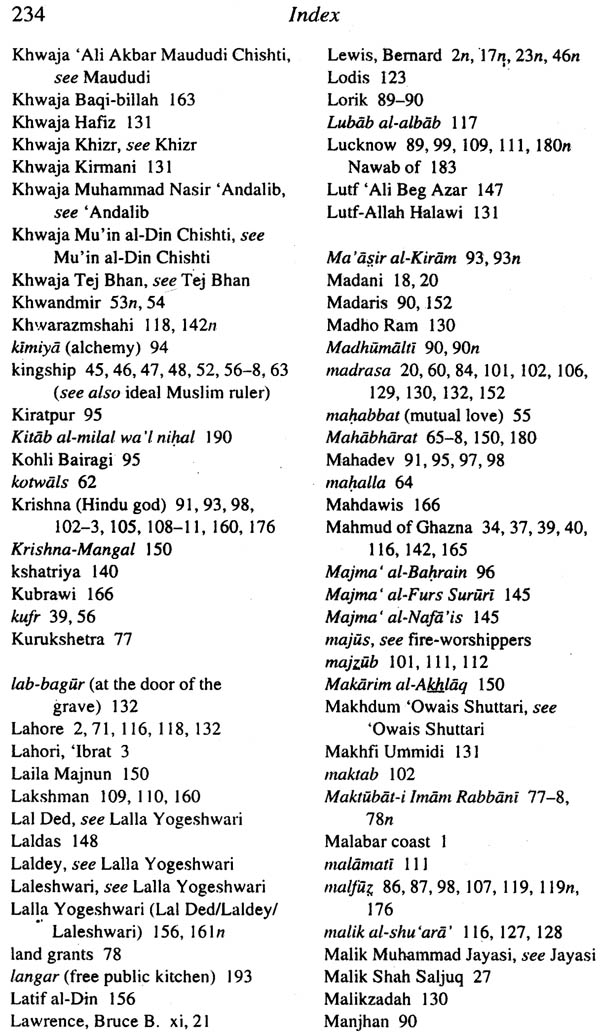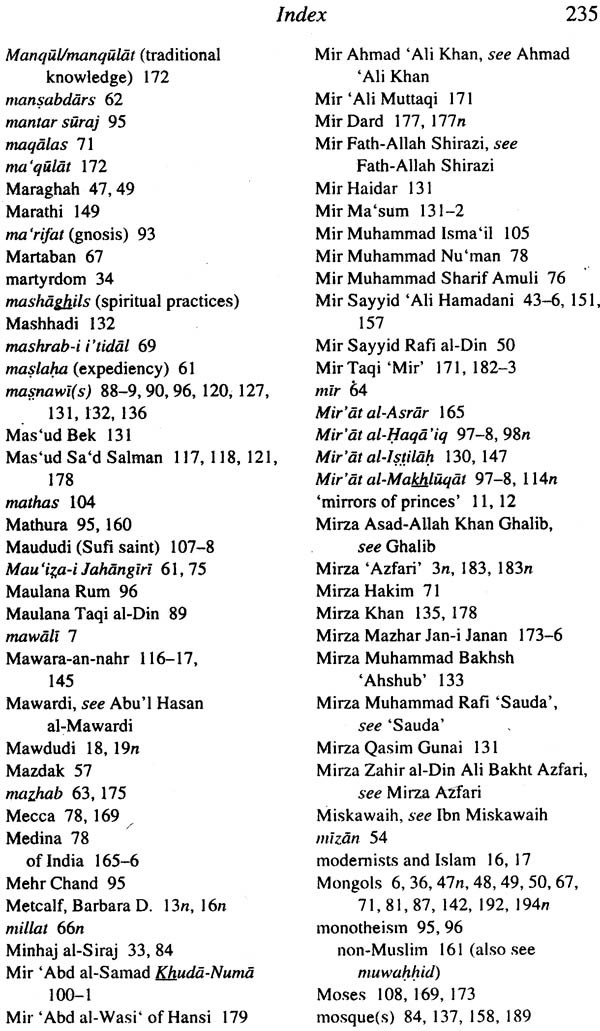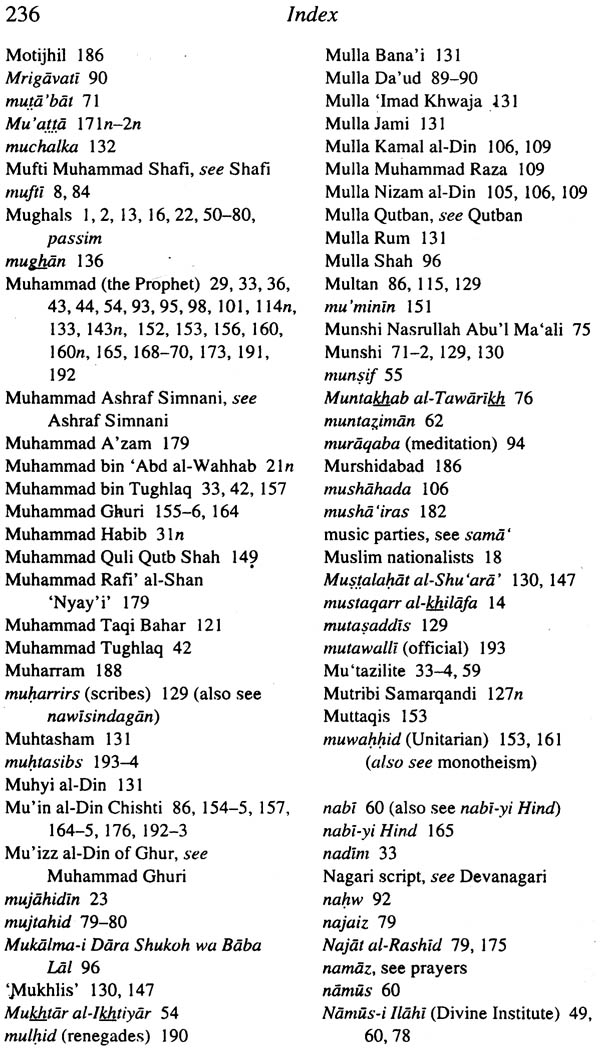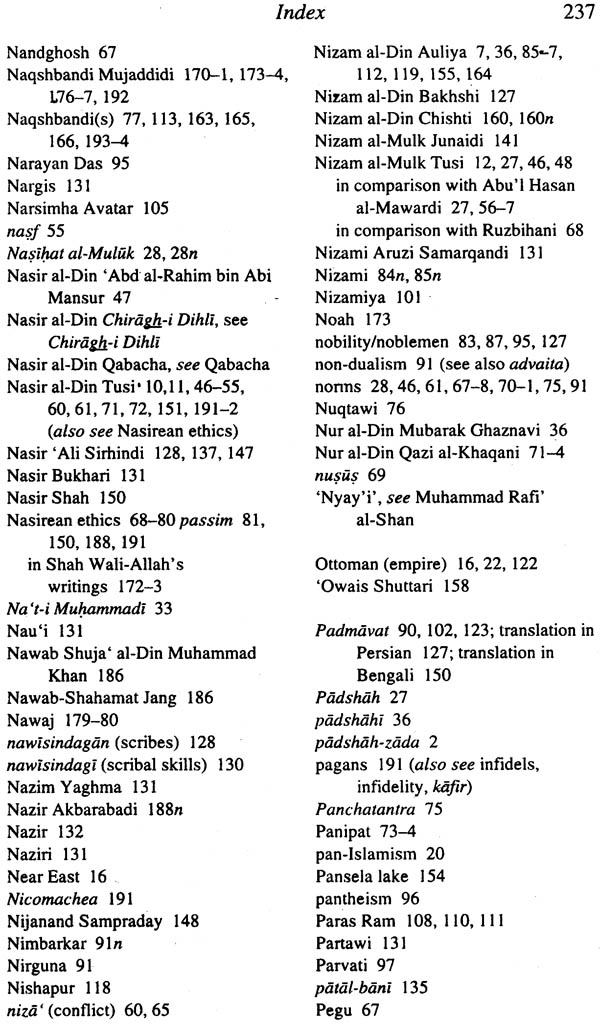
The Language of Political Islam in India c. 1200-1800
Book Specification
| Item Code: | NAG574 |
| Author: | Muzaffar Alam |
| Publisher: | Permanent Black |
| Language: | English |
| Edition: | 2010 |
| ISBN: | 9788178242231 |
| Pages: | 260 |
| Cover: | Paperback |
| Other Details | 8.5 inch X 5.5 inch |
| Weight | 250 gm |
Book Description
About the Book
This book shows the ways in which political Islam, from its establishment in medieval north India, adapted itself to a variety of Indian contexts and became deeply Indianized.
Pre-existent Arabo-Persian traditions were moulded to new Indian contexts, involving changes in the manner in which Islamic rule was conceived and conducted in the subcontinent. Muslim sultans (and later the Mughals) and medieval writers on Islamic morality, theology, and political doctrine, created major shifts in Islam's conceptual and institutional vocabulary. In this process of acculturation, political Islam in India was forced to reinvent itself as a doctrine of rule.
A second change was the shift in the meanings of key Islamic terms, especially those pertaining to statehood, and relations between rulers and subject populations. Through close readings, Muzaffar Alam shows that the vocabularies in use went through changes so fundamental that the language of Indian Islam became quite different from what was in vogue in contexts outside.
With its profound deployment of primary and secondary sources, this book provides major insights into the changing nature of political Islam in India.
About the Author
Muzaffar Alam is Professor in the departments of South Asian Languages and Civilizations, and History, at the University of Chicago.
Preface
This book has germinated out of the S.G. Deuskar Memorial Lectures which I delivered at the Centre for Studies in Social Sciences, Kolkata, 111 December 1996. When invited by the Centre's Director, Professor Amiya Bagchi, to deliver those lectures, I was engaged in research concerning the nature of a putative 'composite culture' in medieval India which would avoid excessive emphasis on subjects such as Sufism, which are normally treated as central to any such discussion. I had in fact, in certain earlier works, attempted to show that the role of the medieval state, rather than that of the Sufi orders, was crucial in bringing together some of medieval India's major communities. By this means I had tried to nuance the standard understanding of the place of Sufis within areas such as eighteenth-century Awadh.
From this point of departure, it seemed logical to go beyond questions about administrative intervention by the state and to look more closely at the constitution of ideology in medieval north India's Muslim states, with a view to understanding their relations with the wider world of Iran and Central Asia. I therefore began to look at the rich but, in the Indian context somewhat under-studied, textual tradition of treatises on political ethics and political culture within this broad area. I quickly realized that a very radical change had come about in this tradition, within the worlds of eastern Islam, during the course of the move from the use of Arabic to the use of Persian.
The present work is made up, thus, of two related reflections, both located in the context of Islam in the Indian subcontinent. One centres largely on the issue of political thought and ethical treatises (sometimes assimilated in the so-called 'Mirror of Prince ' tradition). The second is mainly preoccupied with understanding the role played by the Persian language in defining the political culture of the Mughals. In this way, if one part of this book is focused on the language of politics, the other complements it by looking at the politics of language.
To expand a little on the above: I have tried to discuss the ways in which political Islam adjusted itself to Indian traditions, from the time of its first establishment to the decline of Muslim power in the subcontinent. I suggest that the idea and meaning of political Islam changed alongside the process and experience of rulers of this persuasion actually finding themselves wielding power in north India. Many of the rulers as well as a large number of the political theorists of these centuries clearly suggest the view that, for successful Islamic rule within a region predominantly non-Muslim, the originary language and traditions of Islam cannot escape modification. Theory, orthodoxy and fundamentalist positions are thus questioned by actual practice in new contexts, and it is in fact common knowledge that Muslim political power in India developed forms of governance that were all its own. As importantly, the vocabulary of this new governance underwent significant transformation. Deploying a variety of medieval sources-normative treatises, Sufi texts, collections of belles-lettres-I have attempted here to illustrate how the Indian experience of political Islam maintains continuities as well as differences with Islamic power elsewhere.
No singular tradition emerges from these texts, nor from the cultural practices of the subcontinent's Muslims. We see, rather, a series of efforts to contest cultural and political traditions within the internal framework of Muslim power and social practice. Many scholars have contributed to our present understanding of the economic, political, and cultural facets of this period, but I believe few have attempted to integrate them in order to provide an understanding of the connection between the ideals and actual practices of Muslim politics. This book is an attempt in that direction: it seeks to pull into one narrative aspects of the subcontinent's medieval Islamic politics and language, its ideals and multiple realities, which have hitherto been treated as discrete. The book thus also seeks to contribute to contemporary debates concerning the relationship between, on the one hand, normative and textual Islam, and, on the other, changing social and political practices.
In the end, I remain acutely aware of the limitations of my work.
I believe its purpose will be more than served if scholars younger than myself use it as a springboard to examine with greater depth and scholarship the issues I have attempted to raise within it.
Some parts of this book have appeared earlier, in varying forms and formats, some as independent essays deriving from my participation in various seminars within India and elsewhere. That patchwork has yielded this new form, a book which, I believe, reveals that the 'issues treated within it have an internal logic and coherence which goes well beyond the sum of its many, and sometimes fragmented, parts. I had, initially, hoped to add another chapter to this book-on the place of Sufism (particularly with reference to the sixteenth, seventeenth and eighteenth centuries), but was eventually persuaded that that perhaps merits a book in its own right. Areas of this book will be visible in one form or the other in Tradition, Dissent and Ideology, ed. R. Champakalakshmi and S. Gopal (Delhi: Oxford University Press, 1996); Modern Asian Studies, 32, 1998; The Making of the Indo-Persian Culture, ed. M. Alam, F. Delvoye, andM. Gaborieau (Delhi: Manohar, 2000); Beyond Turk and Hindu, ed. David Gilmartin and Bruce Lawrence (Gainesville: University Press of Florida, 2000); Literary Cultures in History, ed. Sheldon Pollock (Berkeley: University of California Press, 2003).
As regards the spelling and translation of Perso-Arabic words, I have generally followed the system adopted by F. Steingass in his Comprehensive Persian-English Dictionary. I have, however, diverged from Steingass when transliterating word combinations and compounds. I ha ve preferred to put a hyphen (-) between the first word and the letter' i', indicating its combination with the second word. In Perso-Arabic combinations, the Arabic definite article has been consistently written as 'al'. I have thus written sulh-i-kull, Nizam al-Dinand al-Rahman, while Steingass would have transcribed them as sulh-kull, Nizamu'din and Abdu'r rahman.
Introduction
What is the political culture of Islam? Has it been static throughout history? Have Muslims always ruled by the sword, or did they also evolve strategies of cultural accommodation in the lands where they spread their faith and established their power? If we assume the latter, then were these strategies simply the result of a banal pragmatism, or can we also find evidence of an intellectual-even moral-transformation resulting from such accommodation? In other words, is there historical evidence of a political Islam quite different from that projected by today's Islamist radicals?
This book is an attempt to understand these questions in the context of lslam in northern India from the thirteenth to the eighteenth centuries, the peak of Islamic power in the region. Islam entered the Indian subcontinent soon after its appearance in Arabia, as attested by seventh-century interactions between Arab traders-then newly converted to Islam-s-with their Indian business partners and wives across the Indian Ocean, along the Malabar coast. The eighth century, with the Arab invasion of Sindh, brought political Islam to the northern part of the subcontinent. From the eleventh century, following changes in Islam in the Perso-Turkic world and the expansions of the Ghaznavids, a significant part of northern India was incorporated into the Ghaznavid empire. Islamic power grew further with the establishment of the Delhi Sultanate in the twelfth century, and reached its zenith with the Mughals from the sixteenth century through the middle of the eighteenth century, until the Mughals began to be unseated by regional powers and the British. Yet Muslim power and culture continued to flourish in several regions for a long time to come. In the history of political Islam, the Indian subcontinent thus occupies a major position-in terms of geographic spread as well as duration.
My study focuses in particular on a body of materials produced in India and elsewhere in the Perso-Islamic world. This is a deliberate choice, my view being that, in order to better understand developments in the political vocabulary and syntax of this period, it is necessary to look at such materials not in isolation but in their wider context of circulation, which in this case was not Arabia as much as Iran and Central Asia.
The word 'vocabulary' has been used here in a very broad sense.
I analyse certain key words connected with the politics of Islamic rule in India, but I do not propose to delineate in detail the philological meanings and significations of these words. Muslim writers used certain terms to denote, for instance, authority, power, state, governance, obedience, resistance, ruler, ruled, victory, defeat, war, and peace. These terms are important, and have been so noted, in considerable depth, by Bernard Lewis in the context of the larger Islamic world. In this book, however, I argue that even in the usages of these key terms there was no continuity or singularity of meaning from medieval times to the present. The word 'sultan'; for instance, referred specifically to the ruler and denoted royal power in the larger Islamic world, as well as in India in the pre-Mughal context. And yet this word had become so common in eighteenth century Mughal India that its meaning had expanded, or rather degenerated into denoting even cousins, distant cousins, and nephews of the reigning monarch-that is to say, even those with no plausible pretensions to power. The word was no longer used, on the other hand, to refer even to the direct descendant of the ruler, who was instead known as the shah-zada or padshah-zada.
Or, for that matter, take Lahore. Though Lahore was only the capital of a Mughal province, ithas almost invariably been mentioned in Mughal chronicles as dar al saltanat (abode of the Sultanate). Yet the governor of this province would never go so far as to assume the title of 'sultan', not even in the days when he had acquired a measure of autonomy.?
My general argument thus centres on the idea that the deeper meaning and content of the political and religious vocabulary in use changed significantly in the Indian context; further, these changes are, in this region's context, often best understood as part of a longer-term evolution which entails understanding the pre-history of their usages outside South Asia. I shall also try to indicate the extent to which the rhythms of change in the long run were affected by the South Asian context: in other words, with what rapidity did a Perso-Islamic polity become Indianized in its conceptions, and, if there were indeed limits to this process, from where did these limits spring?
Contents
| Preface | IX | |
| 1 | Introduction | 1 |
| 2 | Shari'a, Akhlaq and Governance | 26 |
| Shari'a in Early Adab Writings | 27 | |
| Fakhr-i Mudabbir's Adab al-Harb | 29 | |
| Barani's Fatawa-i Jahandari: The Construction of a Past | 31 | |
| Barani on Dinddri and Jahdndari | 35 | |
| The Zakhirat al-Muluk of Mir Sayyid 'Ali Hamadani | ||
| (d. 1384) | 43 | |
| Shari'a in Nasirean Akhlaq | 46 | |
| Political Norms in Akhlaq Literature | 54 | |
| Ethical Norms in Mughal Politics | 61 | |
| Religion and Mughal Political Culture | 69 | |
| 3 | The Sufi Intervention | 81 |
| Another Vision of Power: The Sufis of North India | 82 | |
| The Doctrine of Wahdat al-Wujud | 91 | |
| Integration and Identity: A Sufi Trajectory | 98 | |
| 4 | Language and Power | 115 |
| Persian in Medieval India | 115 | |
| Persian under the Mughals | 122 | |
| The Language of Empire | 128 | |
| Persian and Political Culture | 133 | |
| 5 | Opposition and Reaffirmation | 141 |
| The Problems of Persian and Akhlaq Texts | 141 | |
| The Limits of Sufi Assimilation | 151 | |
| Towards a Reaffirmation | 168 | |
| Concluding Remarks | 190 | |
| Bibliography | 196 | |
| Index | 225 |
